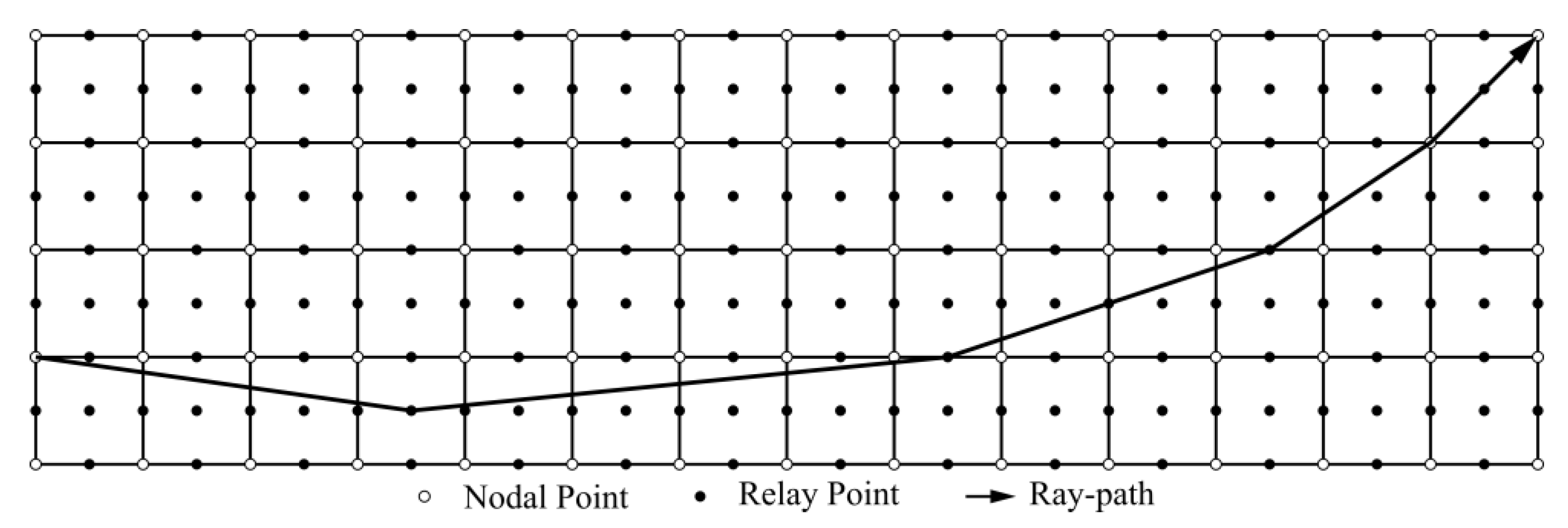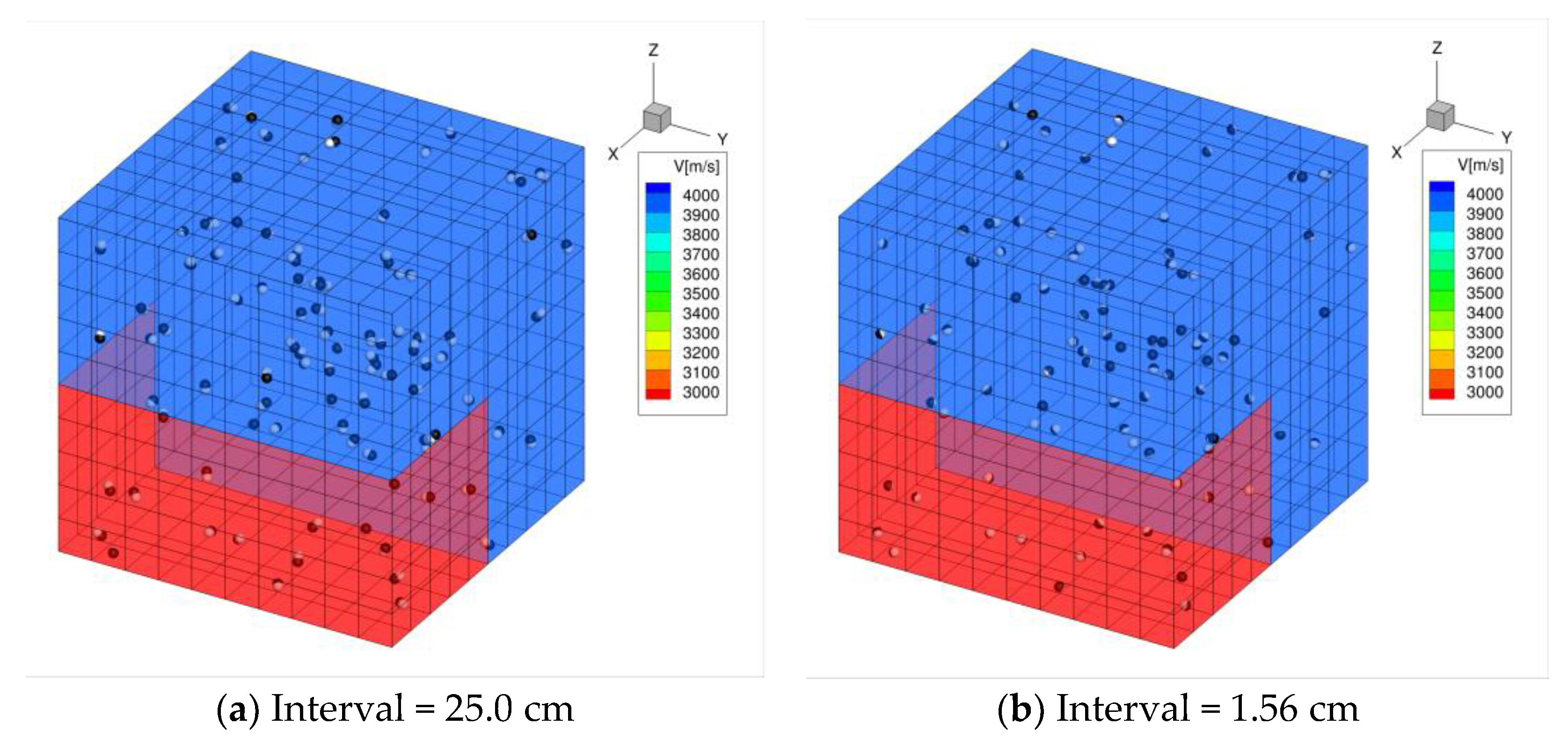The source localization technique that is introduced in this study is developed based on a conventional source localization technique that has been used in AET. The conventional source localization technique is briefly introduced, and the new technique is proposed in this section. Furthermore, the computational conditions for the verifications are also shown.
2.1. Conventional Source Localization Technique in AE-Tomogrpahy
Conventionally, the source locations have been identified on the basis of a ray-trace technique on finite element meshes in AET.
Figure 1 shows an example mesh on the area of interest, and an approximated ray-path. The area of interest is meshed by following the way of the finite element analyses, and the relay points are installed with a specified resolution in the source localization technique. The ray-paths are approximated as polylines, for which the apexes are located at nodal or relay points on the mesh. If it is assumed that elastic wave velocity is constant in individual cells, a travel time on an approximated ray-path is given as follows:
where
is a travel time from point
to point
;
is a length of a ray-path from point
to point
on cell
; and
is a slowness, a reciprocal of elastic wave velocity, of cell
. Although this equation gives a travel time of any ray-paths between two points on the mesh, generally an important ray-path is the one that gives a first travel time. Thus, practically, the travel times of all of the ray-paths between the two points are computed using Equation (1), and then the ray-path that gives a minimum travel time is chosen as the ray-path that gives the first travel time on the ray-trace technique.
The conventional source localization technique is structured on the basis of the ray-trace technique. It is assumed that the locations of the receivers and the arrival times of the elastic waves that are emitted from a source location are known at the receivers on the source localization technique. A conceptual flow diagram of the conventional source localization technique is illustrated in
Figure 2. Firstly, ray-trace is performed from all of the receivers to the nodal and relay points on the mesh, in order to compute the first travel times between them. Then, the potential emission times are computed on every nodal and relay points, as follows:
where
is the arrival time of event
at point
, and
is a potential emission time that is estimated for event
on the basis of the arrival time
at point
. This potential emission time implies that an elastic wave of event
must be emitted at
, if the elastic wave is emitted from point
and arrives at point
, at
. As a consequence, each nodal and relay point has
potential emission times in a single event, if
receivers are installed on the area of interest. It should be noted that the potential emission times should be identical at a point where the elastic wave is emitted, if the representations of the elastic wave velocity distribution and approximated ray-paths are identical to the real ones. However, generally, the point does not exist as the representations are normally insufficient. Therefore, a point where a variance of the potential emission times is minimum is chosen as the emission point in this technique.
The conventional source localization technique identifies the source location at a nodal or a relay point, and this immediately implies that the resolution of the identified source location is determined by the density of the nodal and the relay points.
Figure 3 shows an example of an identified source location on a two-dimensional model. As illustrated in
Figure 3, if a true source location exists in the center of a region that is surrounded by adjacent nodal and relay points, the source location is identified at a location of one of the nodal and relay points. Thus, the maximum error of the source location is half of the longest interval of two of the adjacent nodal and relay points. This fact reveals that the resolution of the source locations is half of the longest interval. This causes errors of a resultant elastic wave velocity distribution, because the arrival times of the elastic wave at the receivers are computed by using the identified source locations and the estimated emission times in AET.
The error of the resultant wave velocity distribution would be severe if the distance between a true source location and a receiver is close, as the error is relatively large in comparison with a length of a ray-path between the true source location and the receiver, and the dense installation of the relay points is required for reducing the errors. However, the computational costs of the ray-trace technique are proportional to the square of the total number of nodal and relay points, and the fine installation of the relay points drastically raises its computational costs. Hence, the fine installation of the relay points should be avoided from a practical point of view.
2.2. A New Source Localization Technique
The authors proposed an improved technique for raising the resolution, with a limited rise in the computational costs. This technique locally raises the resolution by installing extra source candidates in an area surrounded by the adjacent nodal and relay points of a roughly identified source location based on the conventional source localization technique [
3]. Although this technique could reduce the computational costs on the same resolution in comparison with the conventional technique, the computational costs are still expensive if a fine resolution is required or the number of events is large, because the total number of the potential source candidates is also large.
A new source localization technique that has been developed on the basis of the previously introduced source localization technique is proposed in this study. The extra source candidates are installed in the area surrounded by the adjacent nodal or relay points of a roughly identified source location, with an interval that is half of the interval of the nodal and relay points, as illustrated in
Figure 4, and a source location is identified by using the installed source candidates. Then, the extra source candidates are installed again in the vicinity of the identified source location. with an interval that is half of the previous interval, as illustrated in
Figure 4, and the source locations are identified again using the newly installed source candidates. This procedure is iteratively performed until the desirable resolution is achieved, and finally, the source location is identified in the required resolution. This technique is characterized by the method of installation of the extra source candidates, and it is expected that the total number of the points is reduced by using this technique. The extra source candidates are sparsely installed in the compact box in the initial stage, and the resolution become twice in every iterative procedure, by moving the center of the compact box to the newly identified source location, and by changing the interval to half of the previous interval in this technique. This approach drastically reduces the total number of extra source candidates in comparison with the previous technique, in which the extra source candidates must be installed homogeneously with a target resolution in the vicinity of the roughly identified source location.











